Page 425 of 2543
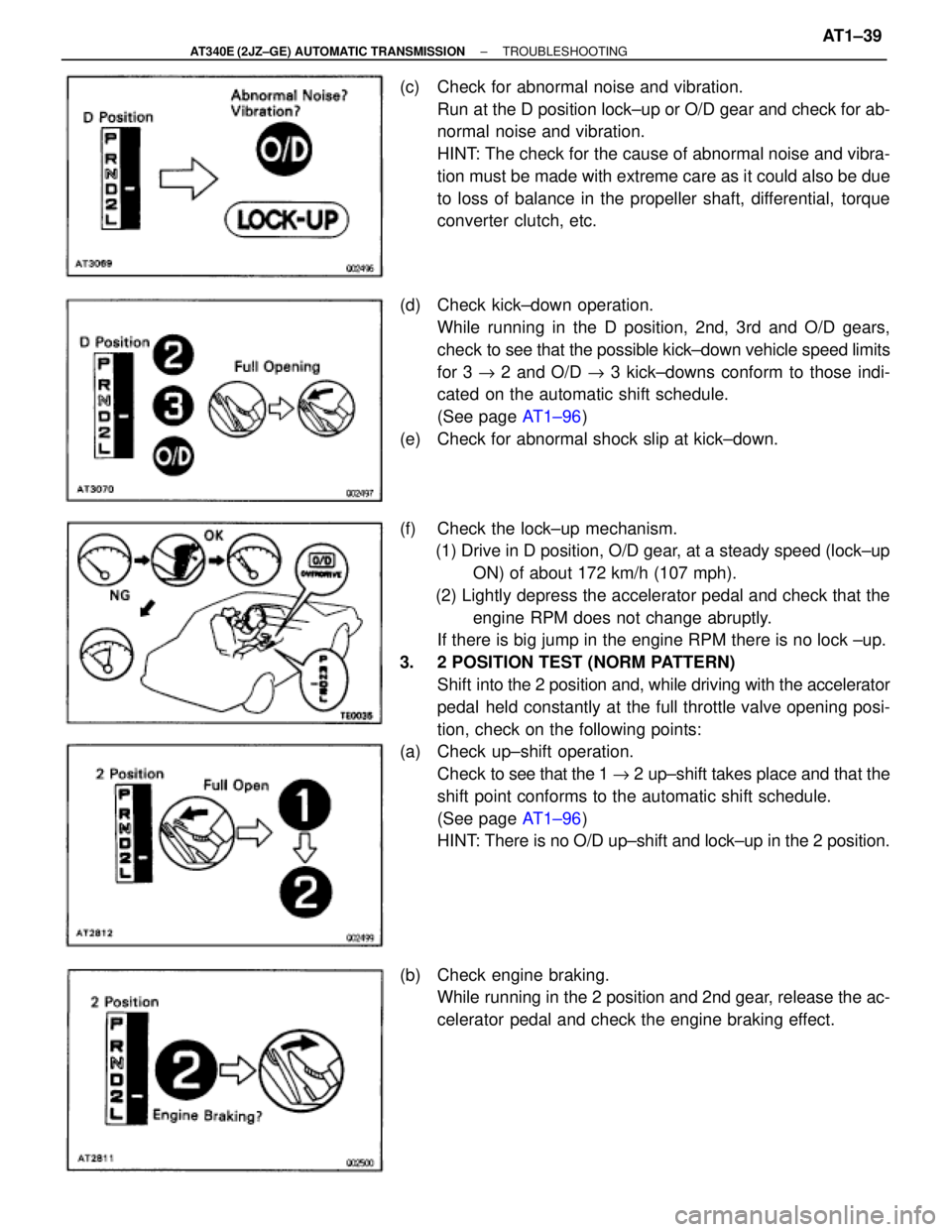
(c) Check for abnormal noise and vibration.
Run at the D position lock±up or O/D gear and check for ab-
normal noise and vibration.
HINT: The check for the cause of abnormal noise and vibra-
tion must be made with extreme care as it could also be due
to loss of balance in the propeller shaft, differential, torque
converter clutch, etc.
(d) Check kick±down operation.
While running in the D position, 2nd, 3rd and O/D gears,
check to see that the possible kick±down vehicle speed limits
for 3 " 2 and O/D " 3 kick±downs conform to those indi-
cated on the automatic shift schedule.
(See page AT1±96)
(e) Check for abnormal shock slip at kick±down.
(f) Check the lock±up mechanism.
(1) Drive in D position, O/D gear, at a steady speed (lock±up
ON) of about 172 km/h (107 mph).
(2) Lightly depress the accelerator pedal and check that the
engine RPM does not change abruptly.
If there is big jump in the engine RPM there is no lock ±up.
3. 2 POSITION TEST (NORM PATTERN)
Shift into the 2 position and, while driving with the accelerator
pedal held constantly at the full throttle valve opening posi-
tion, check on the following points:
(a) Check up±shift operation.
Check to see that the 1 " 2 up±shift takes place and that the
shift point conforms to the automatic shift schedule.
(See page AT1±96)
HINT: There is no O/D up±shift and lock±up in the 2 position.
(b) Check engine braking.
While running in the 2 position and 2nd gear, release the ac-
celerator pedal and check the engine braking effect.
± AT340E (2JZ±GE) AUTOMATIC TRANSMISSIONTROUBLESHOOTINGAT1±39
Page 431 of 2543

EVALUATION
����������������Problem���������������������Possible cause���������������� ����������������Problem��������������������� ���������������������Possible cause
���������������� �
��������������� �
��������������� �
��������������� �
��������������� ����������������
(a) Stall speed low in D and R positions.
��������������������� �
�������������������� �
�������������������� �
�������������������� �
�������������������� ���������������������
wEngine output may be insufficient.
wStator one±way clutch is operating properly
HINT:
If more than 600 rpm below the specified value, the
torque converter clutch could be faulty.
���������������� �
��������������� ����������������(b) Stall speed high in Dposition
wLine pressure too low
wForward clutch slipping
���������������� �
��������������� ����������������
(b) Stall speed high in D position.Forward clutch sli ing
wNo.2 one±way clutch not operating properly
wO/D one±way clutch not operating properly
���������������� �
��������������� ����������������
(c) Stall speed high in Rposition
wLine pressure too low
wDirect clutch slipping
���������������� �
��������������� ����������������
(c) Stall speed high in R position.Direct clutch sli ing
wFirst and reverse brake slipping
wO/D clutch one±way clutch not operating properly
���������������� �
��������������� ����������������(d) Stall speed high in D and Rpositions
wLine pressure too low
wImproper fluid level
���������������� ����������������
(d) Stall speed high in D and R positions.wImproper fluid level
wO/D one±way clutch not operating properly
± AT340E (2JZ±GE) AUTOMATIC TRANSMISSIONTROUBLESHOOTINGAT1±45
Page 432 of 2543
TIME LAG TEST
When the shift lever is shifted while the engine is idling, there will be a certain time lapse or lag before the
shock can be felt. This is used for checking the condition of the O/D direct clutch, forward clutch, direct
clutch, and first and reverse brake.
NOTICE:
wDo the test at normal operating fluid temp. 50±80
°C (122±176 °F).
wBe sure to allow a one minute interval between tests.
wTake 3 measurements and take the average value.
MEASURE TIME LAG
(a) Fully apply the parking brake
(b) Start the engine and check idle speed.
Idle speed:
700 + 50 rpm (In N position and air conditioner OFF)
(c) Shift the shift lever from N to D position. Using a stop watch, measure the time it takes from shifting the
lever until the shock is felt.
In same manner, measure the time lag for N " R.
Time lag:
N
" D Less than 1.2 seconds
N
" R Less than 1.5 seconds
AT1±46± AT340E (2JZ±GE) AUTOMATIC TRANSMISSIONTROUBLESHOOTING
Page 433 of 2543
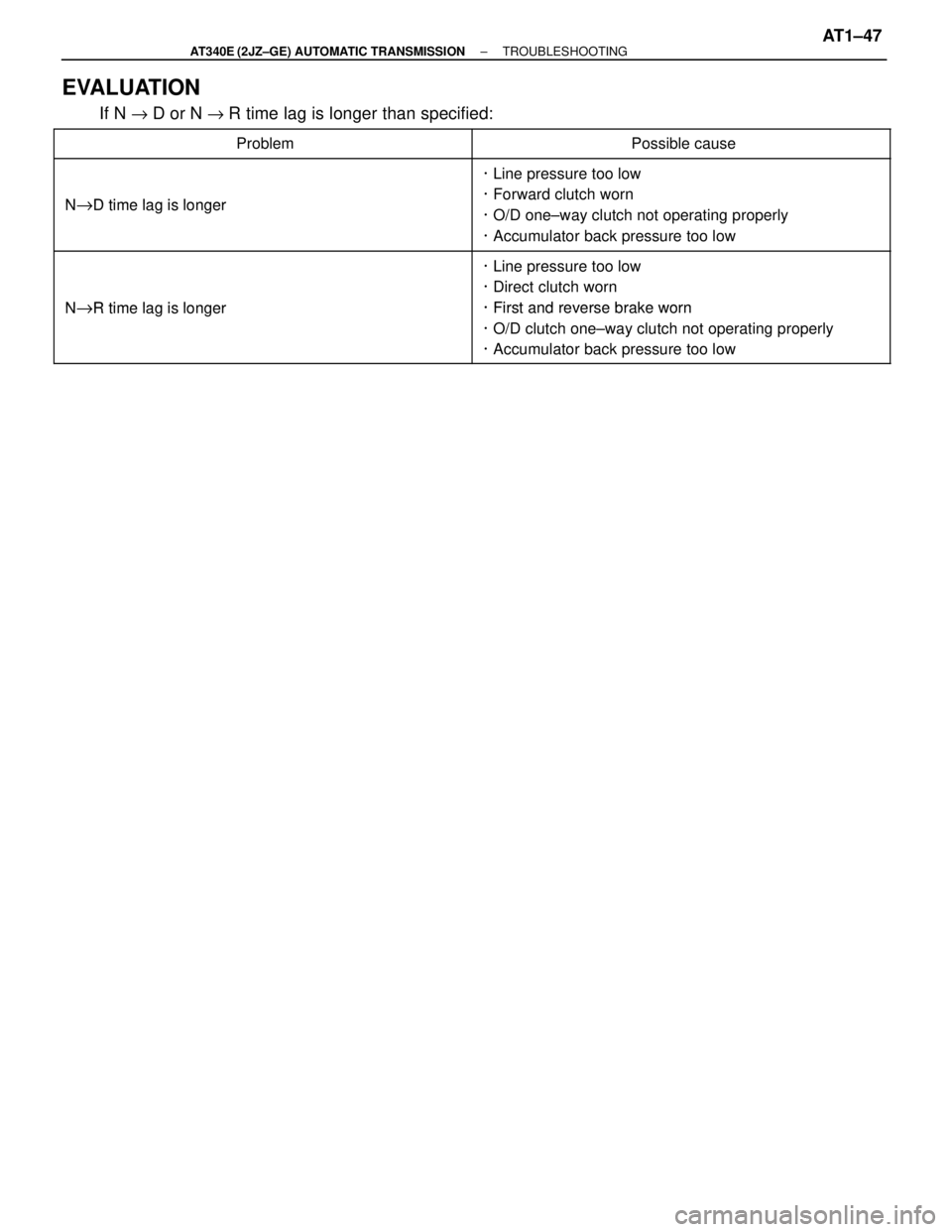
EVALUATION
If N " D or N "R time lag is longer than specified:
������������������ ������������������Problem������������������� �������������������Possible cause
������������������ �
����������������� ������������������
N"D time lag is longer
������������������� �
������������������ �������������������V Line pressure too low
V Forward clutch worn
������������������ �
����������������� ������������������
N"D time lag is longer������������������� �
������������������ �������������������
Forward clutch worn
V O/D one±way clutch not operating properly
V Accumulator back pressure too low
������������������ �
����������������� ������������������
N"R time lag is longer
V Line pressure too low
V Direct clutch worn
VFirst and reverse brake worn������������������ �
����������������� �
����������������� ������������������
N"R time lag is longerV First and reverse brake worn
V O/D clutch one±way clutch not operating properly
V Accumulator back pressure too low
± AT340E (2JZ±GE) AUTOMATIC TRANSMISSIONTROUBLESHOOTINGAT1±47
Page 435 of 2543
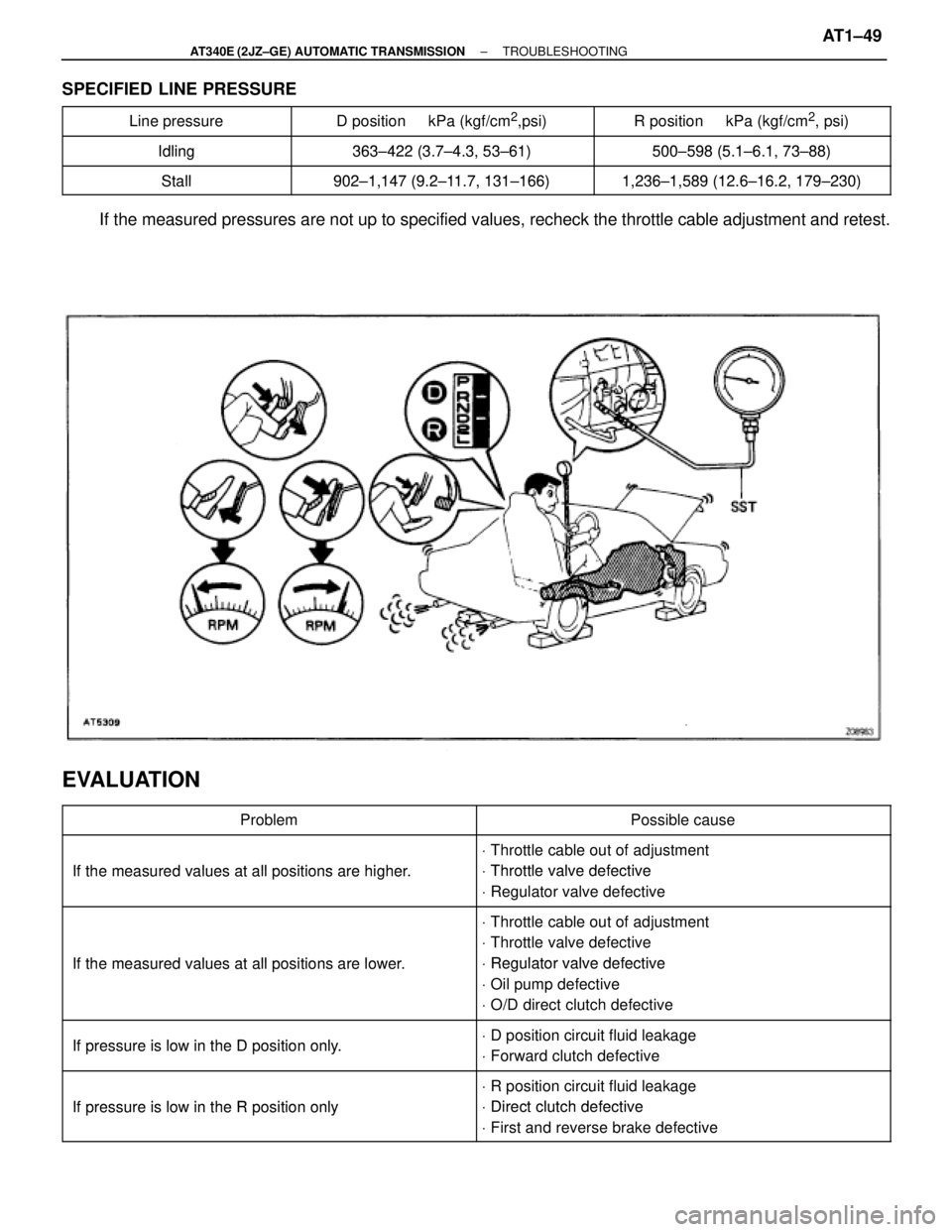
SPECIFIED LINE PRESSURE
����������� �����������Line pressure������������� �������������D position kPa (kgf/cm2,psi)�������������� ��������������R position kPa (kgf/cm2, psi)
����������� �����������Idling363 422 (3 7 4 3 53 61)500 598 (5 1 6 1 73 88)�����������Idling363±422 (3.7±4.3, 53±61)500±598 (5.1±6.1, 73±88)����������� �����������
Stall902 1 147 (9 2 11 7 131 166)1 236 1 589 (12 6 16 2 179 230)����������� �����������Stall902±1,147 (9.2±11.7, 131±166)1,236±1,589 (12.6±16.2, 179±230)
If the measured pressures are not up to specified values, recheck the throttle cable adjustment and retest.
EVALUATION
������������������ ������������������Problem������������������� �������������������Possible cause������������������ �
����������������� ������������������
If the measured values at allpositions are higher
V Throttle cable out of adjustment
Throttle valve defective������������������ ������������������ If the measured values at all positions are higher.V Throttle valve defective
V Regulator valve defective
������������������ �
����������������� �
����������������� ������������������If the measured values at allpositions are lower
V Throttle cable out of adjustment
V Throttle valve defective
Regulator valve defective������������������ �
����������������� ������������������
If the measured values at all positions are lower.V Regulator valve defective
V Oil pump defective
V O/D direct clutch defective
������������������ ������������������
Ifpressure is low in the Dposition onlyV D position circuit fluid leakage������������������ ������������������ If pressure is low in the D position only. D osition circuit fluid leakage
V Forward clutch defective������������������ �
����������������� ������������������Ifpressure is low in the Rposition only
V R position circuit fluid leakage
Direct clutch defective������������������ ������������������ If pressure is low in the R position onlyV Direct clutch defective
V First and reverse brake defective
± AT340E (2JZ±GE) AUTOMATIC TRANSMISSIONTROUBLESHOOTINGAT1±49
Page 448 of 2543
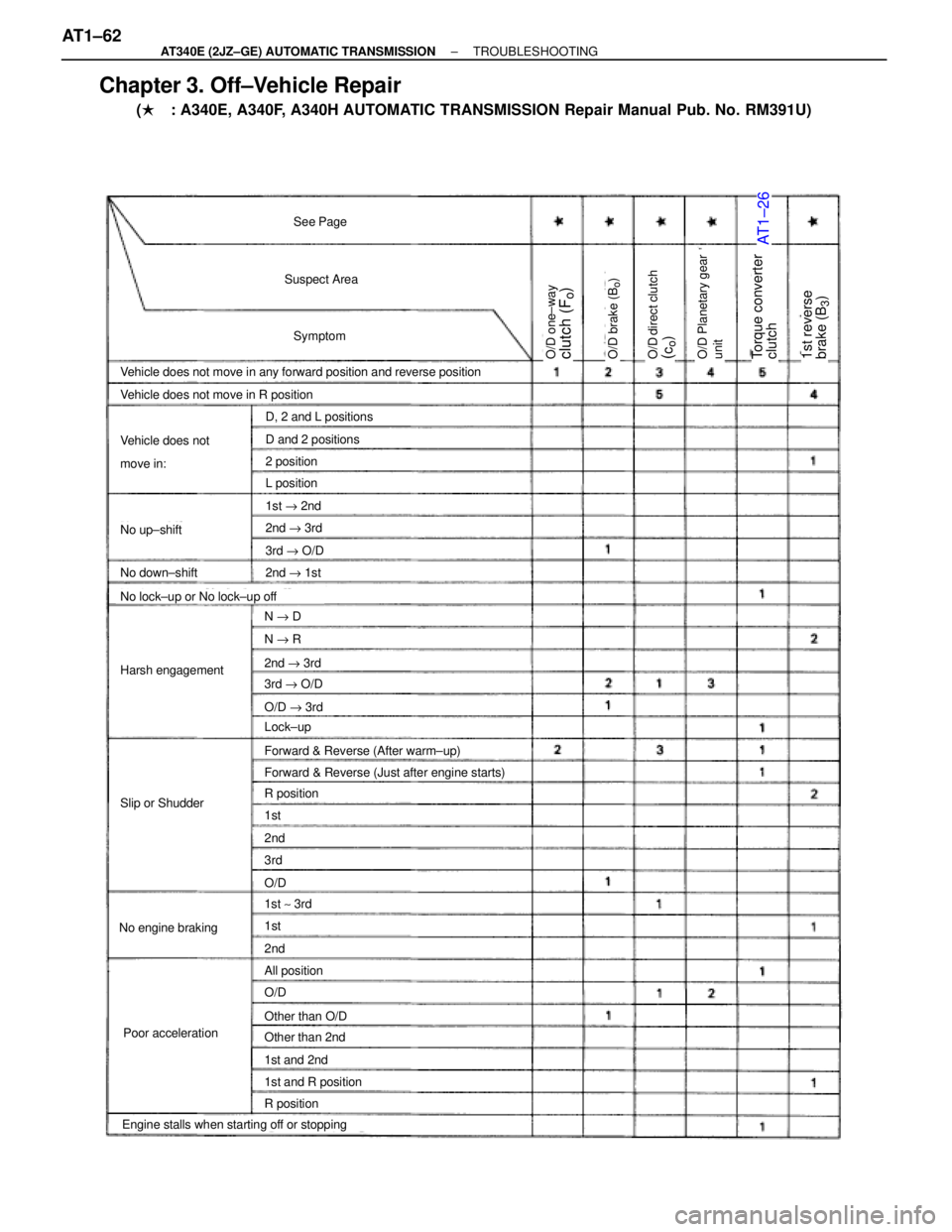
Chapter 3. Off±Vehicle Repair
(��: A340E, A340F, A340H AUTOMATIC TRANSMISSION Repair Manual Pub. No. RM391U)
AT1±26
See Page
Suspect Area
Symptom
Vehicle does not move in any forward position and reverse position
Vehicle does not move in R position
No up±shift
No down±shift
Harsh engagement
Slip or Shudder
1st " 2nd
2nd " 3rd
3rd " O/D
O/D " 3rd
L position
2nd " 1st
D, 2 and L positions
D and 2 positions
2 position
Vehicle does not
move in:
No lock±up or No lock±up off
N " D
N " R
2nd " 3rd
3rd " O/D
Lock±up
Forward & Reverse (After warm±up)
Forward & Reverse (Just after engine starts)
R position
No engine braking
2nd
1st
3rd
2nd
1st
1st ~ 3rd
O/D
O/D
All position
Other than O/D
1st and 2nd
1st and R position
R position
Other than 2ndPoor acceleration
Engine stalls when starting off or stopping
O/D one±wayclutch (F
o)
O/D brake (B
o)
Torque converter
clutchO/D Planetary gear
unitO/D
direct clutch
(co)
1st reverse
brake (B
3)
AT1±62± AT340E (2JZ±GE) AUTOMATIC TRANSMISSIONTROUBLESHOOTING
Page 449 of 2543
2nd coast brake(B1)
Direct clutch (C
2)
No.2 one±way
clutch (F
2)
Forward clutch
(C1)
Front and rear
planetary gear unit2nd brake (B
2)
No.1 one±way
clutch (F
1)
± AT340E (2JZ±GE) AUTOMATIC TRANSMISSIONTROUBLESHOOTINGAT1±63
Page 461 of 2543
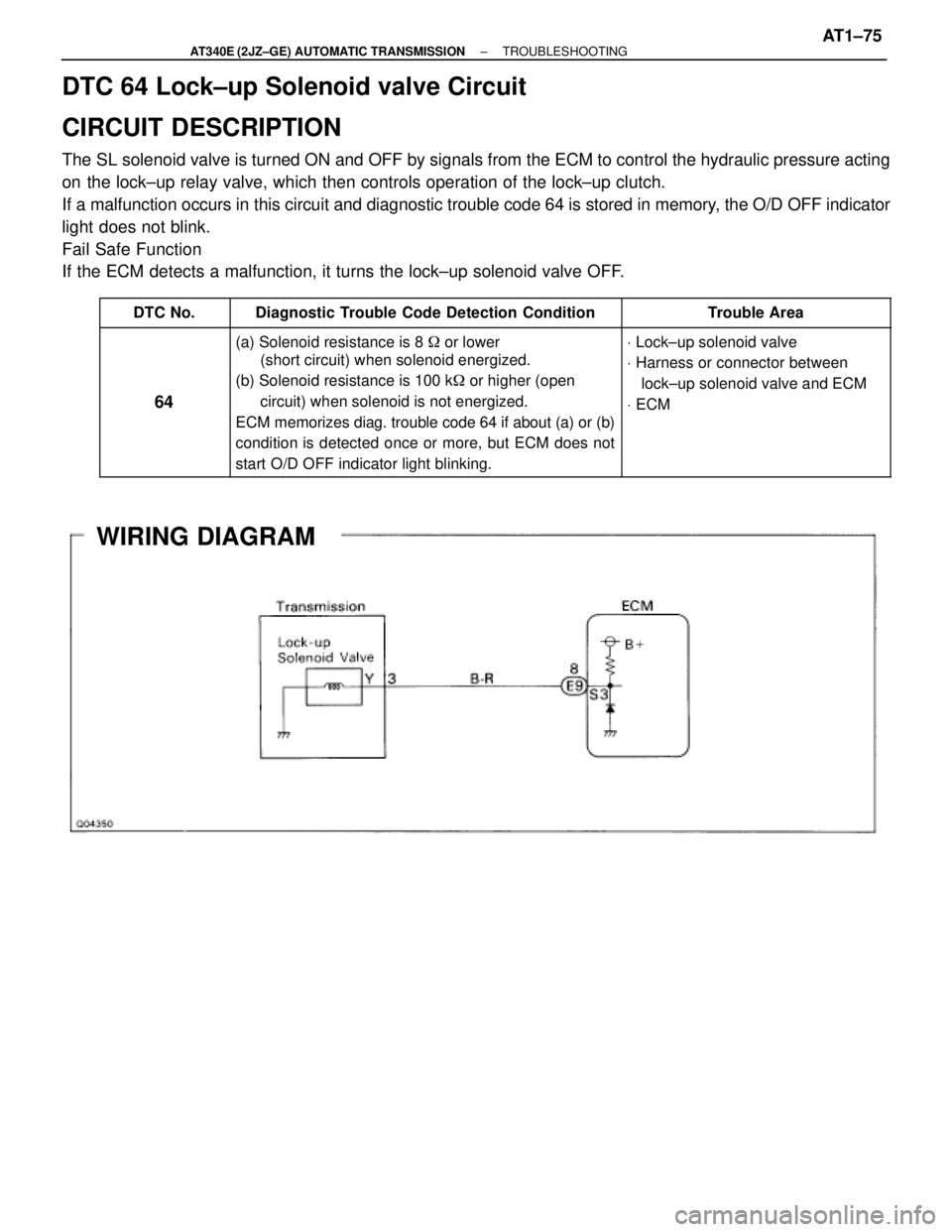
DTC 64 Lock±up Solenoid valve Circuit
CIRCUIT DESCRIPTION
The SL solenoid valve is turned ON and OFF by signals from the ECM to control the hydraulic pressure acting
on the lock±up relay valve, which then controls operation of the lock±up clutch.
If a malfunction occurs in this circuit and diagnostic trouble code 64 is stored in memory, the O/D OFF indicator
light does not blink.
Fail Safe Function
If the ECM detects a malfunction, it turns the lock±up solenoid valve OFF.
������ ������DTC No.����������������� �����������������Diagnostic Trouble Code Detection Condition������������ ������������Trouble Area
������ �
����� �
����� �
����� �
����� �
����� ������
64
����������������� �
���������������� �
���������������� �
���������������� �
���������������� �
���������������� �����������������
(a) Solenoid resistance is 8 � or lower
(short circuit) when solenoid energized.
(b) Solenoid resistance is 100 k� or higher (open
circuit) when solenoid is not energized.
ECM memorizes diag. trouble code 64 if about (a) or (b)
condition is detected once or more, but ECM does not
start O/D OFF indicator light blinking.������������
������������
������������
������������
������������
������������ ������������
V Lock±up solenoid valve
V Harness or connector between
lock±up solenoid valve and ECM
V ECM
WIRING DIAGRAM
± AT340E (2JZ±GE) AUTOMATIC TRANSMISSIONTROUBLESHOOTINGAT1±75